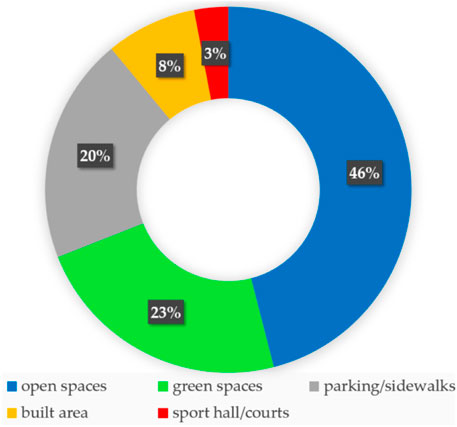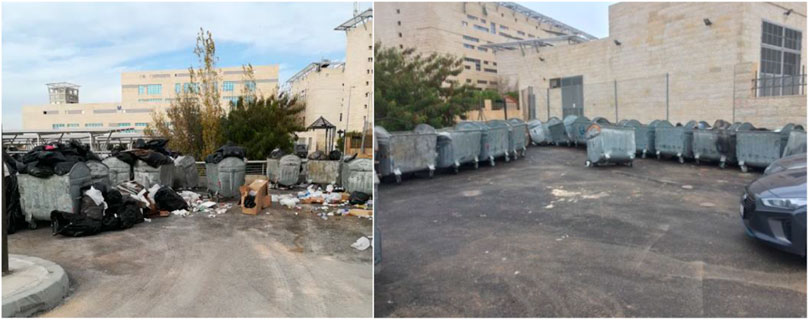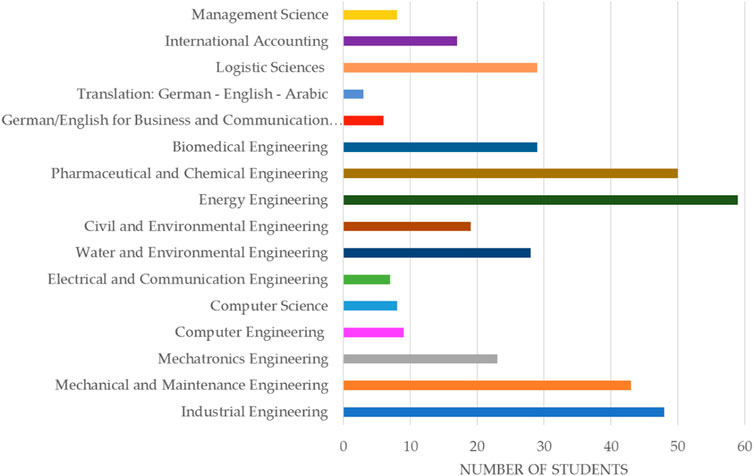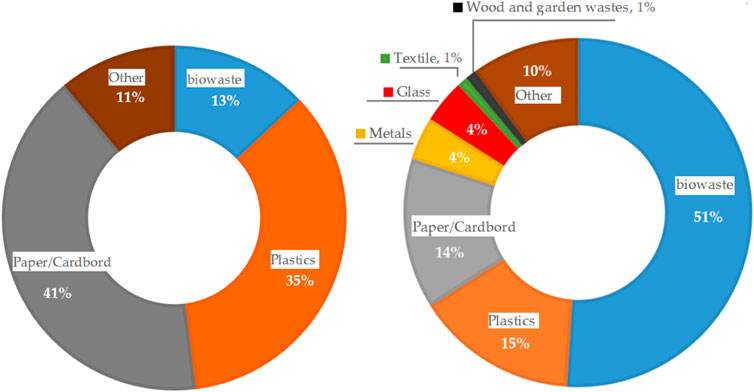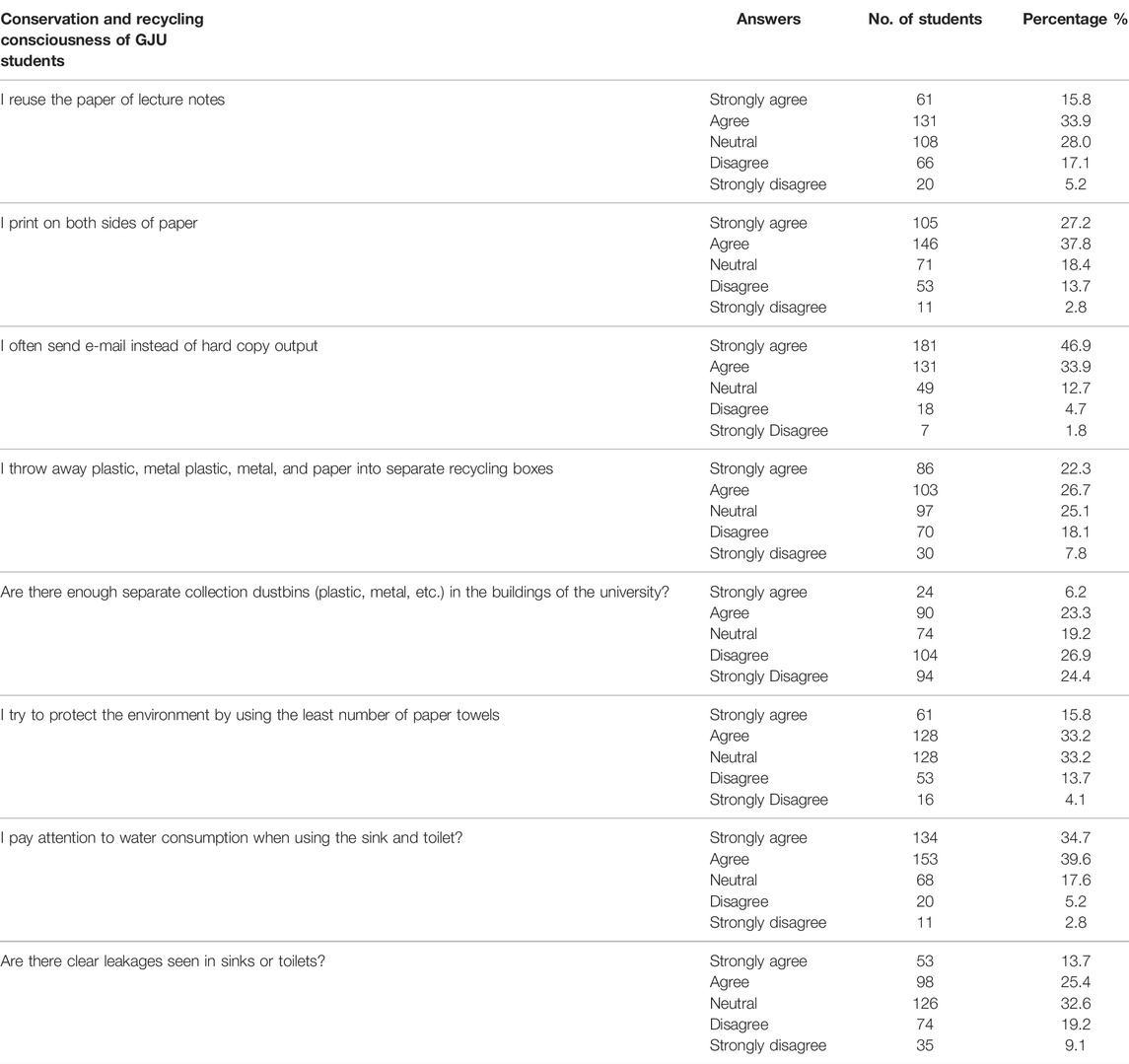- 1Department of Civil and Environmental Engineering, German Jordanian University, Amman, Jordan
- 2Department of Energy Engineering, German Jordanian University, Amman, Jordan
- 3Department of Mechanical and Maintenance Engineering, German Jordanian University, Amman, Jordan
In order to get on the path of sustainable development as a society as a whole, a great transformation is required. Universities are embedded in society and networked with it through various forms of interaction; they influence social discourses and often have a decisive influence on them. As educational institutions, universities have to take a critical stance on the state of our earth and actively fulfill their responsibility. The German Jordanian University (GJU), like any other university, produces solid and hazardous waste. A waste audit was done to identify the waste streams and the opportunities for reinforcing waste reduction, recycling, and composition while enhancing the comprehensive sustainability of a waste management program. The results showed that an average of 2,500 kg of waste was produced per week. The composition of the waste generated at the GJU main campus was 1,051 kg (41%) for paper and cardboard, 875 kg (35%) for plastics, 325 kg (13%) for biowaste, and 275 kg for other wastes. The performed UI GreenMetric showed high potential in the programs to reduce the use of paper and plastic on campus and the treatment of toxic waste with a score of 75 points. The results of this study indicate high potential in the recycling program for university waste, organic and inorganic waste treatment, and sewage disposal. The results for these indicators were moderate, a score of 75 points out of 300 points. Thus, more focus and actions should be placed on these indicators to enhance a sustainable green campus.
Introduction
Green and sustainable campuses are an effort taken by universities throughout the world to ensure mutual prosperity in the future (Sonetti et al., 2016). Campus sustainability has also been the focus of global issues by university planners and policy marked as a result of realizing the impact of university activities on the environment (Alsharif et al., 2020). Similarly, German Jordanian University (GJU) has initiated efforts to try to achieve a sustainable campus at the university level, but the lack of enforcement and policies draws the university back.
The sustainable development and green growth debate is today a major national and international policy issue (Bina, 2013). Although the two words are often used conversely, green and sustainable do not speak of the same concern, where green is associated with the actions that favor more efficient handling of resources and diminish the harmful imprint on the environment. Sustainable specifies the actions that allow a specific issue to be clarified without having downside implications in the future. Green is used in a more immeasurable value correlated to the words sustainable and sustainability (Yanarella et al., 2009). Considering that sustainability is entirely green, it is important to consider that being green does not accordingly make something sustainable.
Sustainable green university rankings are growing in prominence as both students and universities emphasize environmental responsibility. A sustainable green university has been defined as a higher educational institution that addresses, involves, and promotes, on a regional or a global level, the minimization of negative environmental, economic, societal, and health effects generated in the use of their resources in order to fulfill its functions of teaching, research, outreach and partnership, and stewardship in ways to help society make the transition to sustainable lifestyles (Hordijk, 2014). Universities’ educational duty does not terminate with undergraduate and postgraduate learning only but also goes beyond it to the activities that contribute to the development of society (Malay et al., 2014).
GJU is one of 10 public universities in Jordan. Jordan faces many environmental concerns, such as water and solid and hazardous waste management (Saidan and Tarawneh, 2015; Al-Hamamre et al., 2017). Municipal solid waste (MSW), if managed wisely, will have a good impact on the economic development and quality of life, as well as the reduction or elimination of adverse impacts on the environment and human health. MSW in Jordan generates millions of metric tons from municipal, agriculture, and industrial sources every year. The growing industrialization and inflation of the population rate due to the recent forced migration has led to a rapid upturn in solid waste generation in the country, which has put increasing pressure on the existing waste management infrastructure that was not designed for this massive influx of refugees and increase in the daily generation rate of MSW (Saidan et al., 2017; Gibellini et al., 2021).
There are 21 official disposal sites currently operating in Jordan, with only one engineered sanitary landfill, which is the largest landfill (20 km2). It is designed and constructed with biogas collection systems (Jordanian Ministry of Environment, 2020). Considering that Jordan is a lower-middle-income country, the municipal waste composition has almost 51% biowaste and 14% paper/cardboard, where it is preferred to treat waste like composting rather than disposing of it.
Sustainable Universities in the World
Wageningen University and Research, located in the Netherlands, was ranked first among 780 universities worldwide as the most sustainable and greenest university for the fifth year in a row in the UI GreenMetric World University Ranking in 2021 (UI GreenMetric World University Rankings, 2021). UI GreenMetric uses six indicators to rank the sustainability of universities: energy and climate change, waste, water, setting and infrastructure, transportation, and education. Wageningen University and Research (WUR) has fulfilled all six indicators, but the weakest or lowest points were scored in transportation, setting, and infrastructure. Simultaneously, energy and climate change has not scored full points, although WUR has committed to accomplishing 30% energy efficiency in the period 2005–2020 and reduced the CO2 emissions for energy by 79% through three 26-turbine windfarms and the geothermal system in the new building on campus by heating and sustainably cooling these building by means of heat obtained within the sub-surface of the Earth (W. U. A. Research, 2020a). WUR generates sustainable energy, utilizing wind turbines, combined heat and power (CHP) installations, and solar panels. In 2018, 106% of the energy spent was generated by previously mentioned sustainable methods. However, WUR lacks the installation of LED lighting and the deployment of sustainable technology, which affected the score. In other words, the ratio of renewable energy produced by the total energy used is low (W. U. A. Research, 2020b).
Nonetheless, WUR has scored a full point in waste, water, and education. WUR has implemented a waste policy and integrated it on the basis of Lansink’s waste hierarchy (Haezendonck, 2021) for waste management, giving superiority to the most environmentally friendly processing methods. The waste hierarchy describes that prevention and waste management measures are identified in five actions: avoidance, preparation for reuse, recycling, other recovery in particular energy recovery, and backfilling.
The WUR waste policy involves restrictions; for example, the collected waste is not disposed of unless there is no other option; waste is separated at the source and weighed; garden waste and agricultural waste are processed internally and treated using composting and anaerobic digestion; electronic waste is recycled or processed in consonance with the Waste Electrical and Electronic Equipment Directive; and old paper and cardboard are collected, removed, and processed as “confidential” (W. UR, 2020).
WUR generates approximately two kilotons of waste per year divided by 16 waste streams, for example, hazardous and non-hazardous waste (W. U. A. Research, 2020c). In 2018, the University produced 2.6 kilotons of waste, where 44% of the waste fraction was recycled; 46% was energy-recovered; 6% was sterilized and then processed into meat-and-bone meal for the production of biofuel; 1% was detoxicated, neutralized, and drained; 1% was for wet soil cleaning; and 2% was incinerated, leaving only 69 tons out of 2,608,680 tons of waste generated per year disposed of in a dumpsite, which is equivalent to 0% (V. and. Milieu, 2019). The university itself recommended involving the commitment and contribution of the employers and students in the improvement of the waste sector by organizing debates and workshops on waste prevention on campus (Remy et al., 2013).
The University of Oxford, United Kingdom, took the second place in UI GreenMetric ranking worldwide in 2020 (UI GreenMetric World University Rankings, 2020). The University was established circa 1096, making the completion of a sustainable university very difficult. However, they were able to overcome it. The produced waste is not 100% disposed of in landfills, where 32% is recycled waste with the contribution of the staff and students (E. S. Team, 2017).
Many universities are active in the field of waste management and auditing. For example, at Stanford University, United States, free chemical cleaning standards are used in cleaning. The university has started a program to reduce the generation of waste and increase waste diversion instead of using landfills. It is headed toward the ultimate goal of zero waste, defined as 10% or less going to landfills by 2030 (Stanford Sustainability Goal, 2022). Another example is the University of Brighton, United Kingdom. The university implemented the idea of “recycle, reuse, reduce, and rethink” to every student and staff member. This campaign aims to reduce packaging, reduce paper use, and recycle food waste. Food waste is sent from cafeterias to the anaerobic digester. Recycle bins are placed around the campus (Waste and Recycling, 2022). The Amrita University, New Delhi, India, owns a recycling center that collects every bit of waste in the university. Their annual turnover pays the staff of the waste management center. They send all of their plastic to a local paralysis plant, which generates fuel for the plant. Almost all biodegradable waste generated is composted, which is used for eco-restoration (Self-Study Report, 2020).
Effective waste management is very important to achieving campus sustainability. The university campus is considered the center of various activities involving students, lecturers, staff, and other parties contributing to the consumption pattern of energy, water, and other resources. This study focuses on sustainable development and green growth within a specific community (i.e., universities, namely, at GJU). By reviewing the sustainability and green initiatives taken by universities, this study seeks to identify the key principles and practices important for achieving a sustainable green university campus. These principles are then used as a framework for analyzing the sustainable and green initiatives implemented at GJU. GJU is used as a case study because it is very enthusiastic about sustainability. In addition, this study aims to assess the potential of waste auditing and waste category recycling with the intention that it be initiated at GJU, with the long-term vision that it be extended to other Jordanian or Arabian university campuses.
Description of the Selected Case Study
GJU is a public university located in Mushaqar, Amman, Jordan. The university was founded in 2005 by a Royal Decree, in accordance with a memorandum of understanding reached between the Ministry of Education and Scientific Research of the Hashemite Kingdom of Jordan and the Federal Ministry of Education and Research of the Federal Republic of Germany (About GJU, 2020).
GJU has two campuses located in Amman, the capital of Jordan. Amman is a semi-arid climate area as it is located in the eastern Mediterranean basin by the horizon that separates the Mediterranean climate from the arid climate (Ghanem, 2011; Jaradat et al., 2020). The main campus is located in Mushaqar. The School of Architecture and Built Environment and School of Graduate Studies are located in Jabal Amman. This study addresses the main campus only. The main campus is in a suburban setting with a 30 km distance from the city center of Amman, with nearby residential housing with a low to average population density compared to the city center. There are many agricultural lands and open-green spaces neighboring and surrounding the campus from all sides, providing green views for students and staff.
The main campus area is 200,000 m2 with a 16,720 m2 built area on-site and 6,050 m2 of sports hall and courts, resulting in 177,230 m2 of open spaces, and the ratio of open space area to total area is 12.85%. The design parameters of the campus are said to have approximately 25%, 49,800 m2 out of the total area. There are 857 parking spaces for vehicles with an area of 12 m2 per parking and 14 bus parking spaces with an area of 26 m2. Overall, an area of 39,200 m2 is for parking spaces for vehicles and buses and sidewalks. In general, 106,970 m2 is the sum of the main functional landscape areas out of 200,000 m2, as shown in Figure 1.
Municipal solid waste (MSW) consists of everyday waste used in our lives, such as packaging, bottles, food residue, and papers. At GJU, waste is collected from all eight main buildings, prefabs, caravans, gardens, and pedestrian paths in one accumulation area located on the outskirts of the campus. The accumulation point of waste, shown in Figure 2, is accessible to authorities without them entering the university. The university has had an agreement with Al-Husban Municipality since April 2016 that gets renewed annually by both parties (GJU and Al-Husban Municipality), where GJU pays 14,104 USD per year for the waste collection and transportation service. The agreement states that the municipality is responsible for waste collection from the accumulation point once 5 days per week and transportation to the Madaba landfill located 15 km away from the University’s main campus. The accumulation point contains 19 dumpster containers with four wheels with a capacity from 770 to 1,300 L with a hunchback lid for wide trunnion or wide-comb lifting devices.
Materials and Methods
In order to become a certified green sustainable university, many measures should be considered. The creation of a waste audit report along with the life-cycle assessment of waste as infrastructure assessment will set a framework to achieve the goal, and filling in the UI GreenMetric scoring checklist should be done to focus on cons and recommended solutions.
The management of solid and hazardous waste is one of the main parts of a sustainable green university, which can be analyzed using a waste audit. A waste audit is a mechanism for determining the waste stream. The target is to identify the composition and quantities of waste generated within a given timeframe, along with the recycled, treated, and disposed of quantity.
A survey research method was implemented involving the use of standardized questionnaires, arranging appointments and interviews, sending emails, and making phone calls. For the campus operation and waste categories, appointments were arranged with responsible staff at the Engineering and Maintenance Departments, GJU, whose duties pertained to corresponding management. Moreover, a survey was sent to the head of the Waste Department, who handed the information and data regarding the amount of waste generated per day and proportions of paper, plastic, and can waste caused by campus operations of all buildings, including prefabs, clinics, and kindergartens, as well as food and dining services offered by the cafeterias. Furthermore, data were collected regarding the number of janitors and employees working in the waste department, the number of waste containers, their capacities, and the days with peak waste.
The structured questionnaire was distributed on multiple platforms to reach the maximum number of students. The survey was posted/sent on Facebook groups, GJU Email, and WhatsApp. GJU had 4,324 enrolled undergraduate and postgraduate students for the academic year of 2019/2020, of which the main campus had 3,440 undergraduate students. The survey reached more than 10% of the total number of students in the main campus. There were 386 responses from GJU students, the majority with an engineering background.
Figure 3 shows the frequency of responses to the structured questionnaire, which was distributed. As shown, the highest frequency was from the energy engineering students, followed by pharmaceutical and chemical engineering. The least frequency was from the languages department. In general, engineering students and logistic sciences had the greatest frequencies among all.
A waste characterization process was done to determine solid waste generation and composition in the campus. The characterization was developed by students earlier in April 2019, targeting the GJU main campus. The study began from the day the municipality collected the waste and ended before the day of emptying. Each dumpster container was filled with an average of 12–13 full black plastic bags that were collected from across the campus and moved to the accumulation point. An estimated number of 204–221 bags is generated each week from the University, making approximately 42 bags of trash generated daily. The study was conducted on five black plastic bags randomly picked from the accumulation point. Then, the bags were weighed together to have the total waste weight. After that, the waste was sorted into four categories based on the waste material type. The four categories were paper, plastic, food scraps, and others (metals, glass, and sanitary waste). Each category was weighed, and an analysis was performed to determine the composition of the waste.
Results and Discussion
The results showed that an average of 2,500 kg of waste was produced per week (including the weekend). The composition of the waste generated at the GJU main campus is illustrated in Figure 4 (left). Comparing GJU generated waste with municipal waste is considered an important reference. Figure 4 (right) shows the composition of municipal waste generated in 2020.
The results provide understanding and guideline data for addressing precise waste materials and the portions with enormous potential for waste minimization and separation. Figure 4 clearly shows the difference in the percentages of waste composition between the university and the municipality for reasons related mainly to the nature of consumption. The composition of the waste produced at GJU shows that biowaste was almost four times less in GJU than municipal waste, and paper/cardboard and plastics were 2.9 and 2.3 times more in GJU than municipal waste.
Paper Recycling Program
GJU has not yet created a policy for formal waste management, waste reduction, or recycling. However, it has signed an agreement with a paper recycling company to recycle paper waste such as used exam papers. The agreement was signed in January 2019, which includes, for every ton of paper waste, 42 USD is the payback or 12 reams of paper. GJU preferred to take reams of paper instead of money. GJU targeted its greatest waste composition, paper and cardboard, with over 41% of the total waste. Although the payback is too small, this initiative has a great impact on advising staff members and students to recycle waste. Overall, discarded paper and inorganic waste (plastic, metals, etc.) are partially treated or recycled, while organic waste (discarded vegetables, food scraps, etc.) are sent to landfills with no treatment, recovery, or recycling.
Sewage Waste
Sewage waste collected from the wastewater treatment plant is aspirated every couple of days or when needed and disposed of also in the Madaba landfill. A small amount is fed back to the treatment plant as a source of food for the bacteria to maintain its operation for survival. The sewage disposal quantities for years 2018 and 2019 up to March 2020 are listed in Table 1. In general, an average of sewage waste of 4,000 to 5,000 m3 is disposed of yearly with a rate of 15 m3 for each transfer to the landfill (about 300 trips per year).
Hazardous Waste
Hazardous waste is defined as waste prescribed by the regulations, where the waste has any of the characteristics mentioned in Annex III to the Basel Convention (Callao et al., 2021). These characteristics incorporate explosive, flammable liquids/solids, poisonous, toxic, ecotoxic, and infectious substances. Hazardous waste generated on campus is only through laboratories’ experiments in the School of Natural Resources Engineering and Management and the School of Applied Medical Sciences.
The School of Natural Resources Engineering and Management uses basic chemicals in experiments, such as bases and acids in a very small concentration. Hazardous compatibility is considered, and because most solutions are prepared right before the experiments, this minimizes the risk of reactions and other consequences. All chemicals are labeled and classified into concentrated and diluted solutions, where the concentrated solutions are kept in the fume hood and the diluted solutions are kept under the fume hood. Those chemicals get diluted after usage and are poured into the sinks afterward. The stored hazardous waste is only chemical oxygen demand (COD) kits and has been accumulated for more than 3 years. More than 145 chemicals are commonly used in the lab.
Moreover, the School of Applied Medical Sciences uses organic chemicals and more dangerous chemicals. Nevertheless, they manage to maintain hazardous compatibility and separate them into two categories, chlorinated and non-chlorinated. All chemicals are labeled and classified. Hazardous waste is stored and accumulated with an approximation of 1 kg generated yearly. The school orders almost 117 chemicals annually, with very hazardous chemicals, such as benzene, xylene, terylene, and aromatic compounds.
There is a committee for hazardous waste in GJU overall, but little or almost no effort has been exerted by the committee members so far. There are also no clear management and responsible people addressing hazardous waste, and no serious actions have been taken by assigned people.
Environmental Awareness
Environmental awareness is defined as the understanding of the vulnerability of the environment and the significance of its conservation. As part of obtaining a sustainable and green university, the engagement of the society, including students and academic and administrative staff, is important to establish a green society within the university. GJU has more than 11 student organizations related to sustainability, and students participate each year in more than 23 events hosted for sustainability.
A component of the survey is to measure the level of environmental consciousness and awareness of the students. The awareness and concern of the students about environmental sustainability are shown in Figure 5.
Most students have little knowledge of environmental sustainability, but they have a great concern and interest in it. There was a considerable number of students willing to participate in sustainability initiatives. The minority were the students with no clue regarding any topic in relation to environmental sustainability. In conclusion, there is an attentive role from GJU’s students toward environmental sustainability.
Furthermore, more than half of the students who filled out the survey found that it is necessary for students to take courses correlated to environmental and sustainability awareness, as shown in Figure 6. However, the lack of proposed courses that address related topics to sustainability is still a great hindrance.
Waste prevention requires social awareness, and universities have a great role in this regard by holding lectures and seminars to train the students first, in addition to training and educating the local community. Waste management may result in high costs for the university. However, the prices of recyclable materials in the local market may offset the costs and even exceed it into profits. Recently, the world has been facing a significant increase in the prices of plastics and many metals such as aluminum.
Conservation and Recycling Consciousness
Besides environmental awareness level, it is necessary to measure the practices and implementation of the waste reduction of the students. GJU’s students are acquainted with values, ethics, attitudes, and skills in implementing problems related to the environment. Table 2 shows the results of the questionnaire.
In general, most students recycle papers and try to follow paper waste reduction practices as much as possible. Moreover, a big portion of students separate municipal waste in the assigned separate recycling boxes, although, remarkably, students find that there are not enough separate recycling bins at the university campus.
A review of the waste management policies for the highly ranked universities in the UI GreenMetric was accomplished. UI GreenMetric has six categories: setting and infrastructure (SI), energy and climate change (EC), waste (WS), water (WR), transportation (TR), and education and research (ED). Each category has several indicators which reflect the appropriateness of each indicator in the form of points. Under the category waste, there are six indicators, each with 300 points: WS1 (recycling program for university waste), WS2 (program to reduce the use of paper and plastic on campus), WS3 (organic waste treatment), WS4 (inorganic waste treatment), WS5 (toxic waste treatment), and WS6 (sewage disposal). Table 3 shows the UI GreenMetric outcomes for the waste generated at GJU for the year 2020.
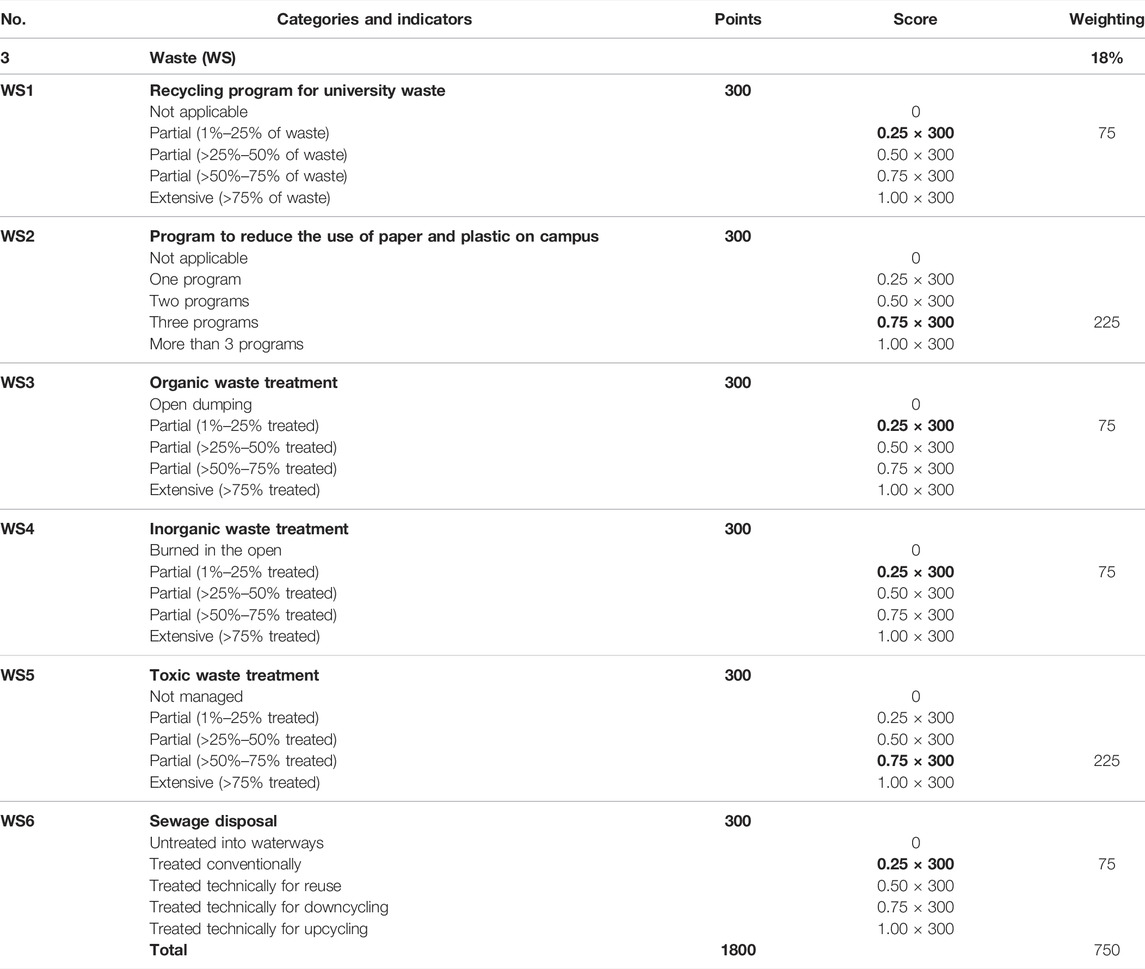
TABLE 3. The UI GreenMetric outcomes for the waste generated at GJU for the year 2020. The bold values represent the maximum score (300) and the score at GJU.
GJU scored 750 out of 1,800 in waste with partial results (75 points) in the recycling program for university waste, organic waste treatment, inorganic waste treatment, and sewage disposal. The UI GreenMetric waste category gives 1,800 points for the waste category. With 300 points for each of the six indicators as given in Table 3. The results of this study indicate high potential in the recycling program for university waste, organic and inorganic waste treatment, and sewage disposal. The results in this study were moderate with a score of 75 points in the previously mentioned waste sub-categories compared to those of leading universities such as WUR, with a full score of 300 points in each sub-category. This means that more focus should be placed on these waste indicators. The scores were 225 points in the programs to reduce the use of paper and plastic on campus and toxic waste treatment.
The recommendations that need to be considered to make GJU as well as Jordanian universities greener and sustainable can be considered based on the results obtained in Table 3. Four UI GreenMetric indicators are dedicated to solid waste (WS1, WS2, WS3, and WS4). Therefore, identifying weaknesses in these indicators can be used to enhance the university campuses. For indicator WS1 (recycling program for university waste), which got 75 points out of 300 points, there is a need to do more investigations. Reuse as a waste-management strategy must be applied for books, computers, and furniture on campuses. This will result in less waste being sent to landfills. Recyclable waste needs to be separated and collected on-site in these universities and recycled off-site at specialized facilities. Recyclables include paper and cardboard, plastic, metal, and glass. Moreover, electronic waste, batteries, and lamps need to be collected separately and either recycled or treated in a responsible manner. This is also valid for organic waste treatment (WS3), which got a score of 75 points too. Organic waste could be treated by anaerobic digestion at a facility on campus for electricity production or as a soil conditioner for agricultural applications.
As waste prevention is at the top of the inverted pyramid of the waste hierarchy, actions to reduce paper and plastic waste need to be implemented at GJU. These programs are of low cost, such as introducing a charge for disposable cups and plates and reducing paper documents by digitalizing paperwork and double-side printing. The introduction of water fountains on the university campus is another strategy to reduce the purchase of water bottles.
Conclusion
The present work represents waste auditing at the GJU main campus. An investigation of solid waste management system performance potential for GJU in the context of environmental benefits was performed. The analysis was conducted following UI GreenMetric waste category indicators. The applied methods and the obtained results are of high value to the universities in Jordan and universities in Arab countries.
The study revealed that, at GJU, an average of 135 tons of mixed waste is produced each year, of which compostable waste accounts for around 17 tons, recyclables account for around 103 tons, and non-recyclables account for around 15 tons. The performed UI GreenMetric showed a high potential in the programs to reduce the use of paper and plastic on campus, as well as in the treatment of toxic waste with a score of 0.75.
This study clearly revealed the successful initiatives that can be further strengthened and the weaknesses that require greater efforts regarding the generated waste at GJU. This study recommends increasing organic waste treatment by composting and then using the compost as fertilizers for plants. Most of the surveyed students found that the number of separated recycling bins is not enough. Some signs and examples of what/where should be thrown will guide and encourage the students when discarding waste. Furthermore, GJU needs to enforce programs to reduce the utilization of paper and plastic on campus, such as a double-sided printing policy program, using tumblers, printing when necessary, free water distribution to minimize plastic bottles considering that more than 35% of the waste’s composition was plastic. Significant savings in the use of papers will be achieved by implementing policies and training programs for the dematerialization of administrative procedures in the University.
Data Availability Statement
The original contributions presented in the study are included in the article/Supplementary Material, further inquiries can be directed to the corresponding author.
Author Contributions
Conceptualization: MH. Methodology: MH, BH, BA, and YA. Formal analysis: BH, MJ, and AA. Investigation: MH, BA, and YA. Resources: MH, BA, and AA. Data curation: MH and MJ. Writing—original draft preparation: MH, MJ, AA, BA, and YA. Writing—review and editing: MJ and AA. Supervision: BH and MH.
Conflict of Interest
The authors declare that the research was conducted in the absence of any commercial or financial relationships that could be construed as a potential conflict of interest.
Publisher’s Note
All claims expressed in this article are solely those of the authors and do not necessarily represent those of their affiliated organizations or those of the publisher, the editors, and the reviewers. Any product that may be evaluated in this article, or claim that may be made by its manufacturer, is not guaranteed or endorsed by the publisher.
References
About GJU (2020). About GJU. German: German Jordanian University. [Online]. Available at: http://www.gju.edu.jo/content/about-university-48 (Accessed June 19, 2020).
Al-Hamamre, Z., Saidan, M., Hararah, M., Rawajfeh, K., Alkhasawneh, H. E., and Al-Shannag, M. (2017). Wastes and Biomass Materials as Sustainable-Renewable Energy Resources for Jordan. Renew. Sustain. Energ. Rev. 67, 295–314. doi:10.1016/j.rser.2016.09.035
Alsharif, M. A., Peters, M. D., and Dixon, T. J. (2020). Designing and Implementing Effective Campus Sustainability in Saudi Arabian Universities: An Assessment of Drivers and Barriers in a Rational Choice Theoretical Context. Sustainability 12 (12), 5096. doi:10.3390/su12125096
Bina, O. (2013). The Green Economy and Sustainable Development: An Uneasy Balance? Environ. Plann. C Gov Pol. 31 (6), 1023–1047. doi:10.1068/c1310j
Callao, C., Latorre, M. P., and Martinez-Núñez, M. (2021). Understanding Hazardous Waste Exports for Disposal in Europe: A Contribution to Sustainable Development. Sustainability 13 (16), 8905. doi:10.3390/su13168905
E. S. Team (2017). Environmental Sustainability Review 2017. Oxford: University of Oxford. Available at: https://www.ox.ac.uk/sites/files/oxford/media_wysiwyg/Ox_Uni_Sustainability_review_FINAL_INTERNET.pdf (Accessed January 01, 2022).
Ghanem, A. A. (2011). Climatology of the Areal Precipitation in Amman/Jordan. Int. J. Climatol. 31 (9), 1328–1333. doi:10.1002/joc.2160
Gibellini, S., Abu Qdais, H., and Vaccari, M. (2021). Municipal Solid Waste Management in Refugee Hosting Communities: Analysis of a Case Study in Northern Jordan. Waste Manag. Res. 40, 165–173. doi:10.1177/0734242X21994656
Haezendonck, E. (2021). Port Strategy for Sustainable Development. Available at: https://directory.doabooks.org/handle/20.500.12854/68508 (Accessed on January 01, 2022).
Jaradat, M., Al-Addous, M., Albatayneh, A., Dalala, Z., and Barbana, N. (2020). Potential Study of Solar Thermal Cooling in Sub-mediterranean Climate. Appl. Sci. 10 (7), 2418. doi:10.3390/app10072418
Jordanian Ministry of Environment (2020). Waste Sector Green Growth National Action Plan 2021-2025. Amman: the Hashemite Kingdom of Jordan. Available at: http://www.moenv.gov.jo/ebv4.0/root_storage/ar/eb_list_page/20022_jordan_waste_v02_rc_web.pdf (Accessed January 01, 2022).
Malay, D., Zhonghua, G., Deo, P., and Fengting, L. (2014). Greening Universities Toolkit V2.0: Transforming Universities into Green and Sustainable Campuses: A Toolkit for Implementers "UNEP," 2014. [Online]. Available at: https://wedocs.unep.org/bitstream/handle/20.500.11822/11964/Greening%20University%20Toolkit%20V2.0.pdf.
Remy, B., Karolina, B., Georgios, D., Denise, J., Tim, v. M., and Nyima, Z. (2013). Enhance the Sustainability of Wageningen University. Wageningen: Wageningen University and Research. Available at: https://www.greenofficewageningen.nl/wp-content/uploads/2016/06/Final-report-ACT_Sustainability-.pdf (Accessed January 01, 2022).
Saidan, M. N., Drais, A. A., and Al-Manaseer, E. (2017). Solid Waste Composition Analysis and Recycling Evaluation: Zaatari Syrian Refugees Camp, Jordan. Waste Manage. 61, 58–66. doi:10.1016/j.wasman.2016.12.026
Saidan, M., and Tarawneh, A. (2015). Estimation of Potential E-Waste Generation in Jordan. Ekoloji 2015, 60–64. doi:10.5053/ekoloji.2015.25
Self-Study Report (2020). Self-Study Report of AMRITA VISHWA VIDYAPEETHAM – Qualitative Metrics. Available at: https://intranet.cb.amrita.edu/download/naac/NAAC_Peer_Review_Team_Visit_2021/Amrita_SSR_Qualitative_Metrcs.pdf (Accessed January 01, 2022).
Sonetti, G., Lombardi, P., and Chelleri, L. (2016). True Green and Sustainable University Campuses? toward a Clusters Approach. Sustainability 8 (1), 83. doi:10.3390/su8010083
Stanford Sustainability Goal (2022). Stanford Sustainability Goal: Zero Waste by 2030. Available at: https://sustainable.stanford.edu/sites/default/files/Stanford_ZeroWaste_SustainabilityReport_2.6.pdf (Accessed January 01, 2022).
Ui GreenMetric World University Rankings (2020). UI GreenMetric World University Rankings. Available at: https://greenmetric.ui.ac.id/rankings/overall-rankings-2020 (Accessed January 01, 2022).
Ui GreenMetric World University Rankings (2021). UI GreenMetric World University Rankings. Available at: https://greenmetric.ui.ac.id/rankings/overall-rankings-2021 (Accessed January 01, 2022).
V. and. Milieu (2019). Annual Environmental Report 2018. Wageningen: Wageningen University & Research. Available at: https://www.wur.nl/upload_mm/8/0/e/47a6c9e2-8eeb-4cc2-90b3-1878419116c1_WUR_Annual_Environmental_Report_2018.pdf (Accessed January 01, 2022).
Waste and Recycling (2022). University of Brighton: Waste and Recycling. Brighton: University of Brighton. Available at: https://blogs.brighton.ac.uk/sustainability/wasterecycling/ (Accessed January 01, 2022).
W. U. A. Research (2020). CO2 Footprint. Wageningen: Wageningen University and Research. [Online]. Available at: https://www.wur.nl/en/About-Wageningen/Sustainability/Operationalmanagement/Show/CO2-footprint-3.htm (Accessed June 21, 2020).
W. U. A. Research (2020). Energy. Wageningen: Wageningen University and Research. [Online]. Available at: https://www.wur.nl/en/About-Wageningen/Sustainability/Operationalmanagement/Show/Energy-1.htm (Accessed June 21, 2020).
W. U. A. Research (2020). Waste. Wageningen: Wageningen University and Research. [Online]. Available at: https://www.wur.nl/en/About-Wageningen/Sustainability/Operationalmanagement/Show/Waste.htm (Accessed June 21, 2020).
W. Ur (2020). Waste. Wageningen: Wageningen University and Research. [Online]. Available at: https://www.wur.nl/upload_mm/d/6/0/4bfd080d-8c83-4df6-90ed6e917993953_20140325_Afvalbeleid_Wageningen_UR_versie1_engels_intranet.pdf (Accessed June 21, 2020).
Keywords: waste auditing, green university, questionnaire, UI green metric, Jordan, GJU
Citation: Hindiyeh M, Jaradat M, Albatayneh A, Alabdellat B, Al-Mitwali Y and Hammad B (2022) Sustainable Green University: Waste Auditing, German Jordanian University as a Case Study. Front. Built Environ. 8:884656. doi: 10.3389/fbuil.2022.884656
Received: 26 February 2022; Accepted: 28 March 2022;
Published: 26 April 2022.
Edited by:
Loiy Al-Ghussain, University of Kentucky, United StatesReviewed by:
Ahmad Abubaker, Villanova University, United StatesMuhammed Hassan, Cairo University, Egypt
Copyright © 2022 Hindiyeh, Jaradat, Albatayneh, Alabdellat, Al-Mitwali and Hammad. This is an open-access article distributed under the terms of the Creative Commons Attribution License (CC BY). The use, distribution or reproduction in other forums is permitted, provided the original author(s) and the copyright owner(s) are credited and that the original publication in this journal is cited, in accordance with accepted academic practice. No use, distribution or reproduction is permitted which does not comply with these terms.
*Correspondence: Muna Hindiyeh, TXVuYS5IaW5kaXllaEBnanUuZWR1Lmpv
 Muna Hindiyeh1*
Muna Hindiyeh1* Mustafa Jaradat
Mustafa Jaradat